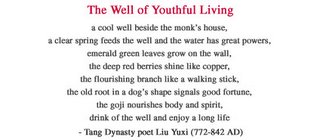Thank you for reviewing this awesome product.
There is an ancient Berry that has a history only recently recognized in the West. It has been present during, and been a witness to, some of the most profound events in Human history, and probably nourished those who played a part in those events.
It graced the walls of the most sacred monasteries in Tibet, grew as the Great Wall was being built, and nourished great dynasties through their rise and fall.
We are talking about the Goji Berry. Latin name: Lycium Barbarum.
Goji is food and everyone knows that natural whole foods especially fruits are "good for you". The Goji Berry can be found as a foundational ingredient in any Traditional Chinese Medicine formula that addresses vitality, longevity, regeneration, immune enhancement or sexual potency.
What is so good about Goji is that it is almost a complete food. Certainly Goji is a complete protein as there are 23 amino acids that we need to live and 9 of these are essential. You must have these 9 to make the other 14. Preferably these should be present in our daily diet. We build new proteins in our body from amino acids. The small amount in Goji doesn’t make it a protein food as such but does contribute to the protein value as some amino acids are growth promoters.
The minerals content is important and the highly mineralized run off from the mountains creates a soil very different from our devitalized farmlands.
The main benefits of Goji can easily be summarized into 3 pillars.
1. Anti-Oxidant (anti-aging) value
2. Immune support
3. Growth hormone and Endocrine support
Anti-oxidant (anti-aging) value
Oxygen is good for you but sometimes oxygen exists in a form that is harmful. The oxygen we breathe is in a double molecule form called O2 (two atoms of oxygen connected like a little dumbell). If you add an extra atom of Oxygen it becomes O3. This is Ozone. O3 is not very stable and is always trying to convert back to oxygen (O2). When this happens, a single atom of oxygen is set free (singlet oxygen). This is also unstable and wants to quickly join up with anything that will accept it, especially preferring any site where there is a deficiency of oxygen.
The result? Low oxygen organisms, such as bacteria, fungus, and yeasts, get frizzled by the frantic singlet oxygen free radicals that try to join up with them. This is a bit like being knocked off your feet by an over enthusiastic St. Bernard running to greet you. Cancer cells, pre-cancerous and damaged cells are also killed- off by this process.
This is all supposed to happen.
The trouble is… we need to make sure that healthy tissue has a way of protecting itself from the over zealous free radicals. We don’t want healthy cells caught up in the chaos. The things that save healthy cells from free radical damage are therefore called Anti-oxidants.
Imagine being stung by 10,000 angry bees continuously. That is similar to what the average cell in our body is experiencing, with free radicals impacting the outside of the protective membrane, which is covered with millions of delicate antenna-like sugar molecules. Such irritation is part of the inflammation process.
Now imagine a beekeeper with his protective suit on. He is now like a cell with adequate anti-oxidants protected from the stings. The thicker the suit the better the protection it provides. The more anti-oxidants we have the better the free radical protection.
We can also reduce the number of bees. In the body we can do this by lifestyle changes that reduce the number of other free radicals produced by avoiding cigarette smoke and pollution, fried fats and microwaved foods, stress, excessive exercise, and excessive sun, to name the common free radical sources. By looking after our liver we automatically reduce free radicals production.
How Do Free Radicals Do Damage?
Each free radical can destroy an enzyme or protein molecule or even an entire cell. The damage is actually even more extensive because each free radical usually generates a chain of free-radical reactions, resulting in thousands of free radicals being released to destroy body components.
Five basic types of damage caused by free radicals:
1. Lipid peroxidation—free radicals initiate damage to fat compounds in the body, causing them to turn rancid and release more free radicals. A chain reaction resulting in billions of "hits" or cell impacts occurs.
2. Cross-linking—free radical reactions cause proteins and/or DNA molecules to fuse together. In the skin this is a wrinkle. In a critical tissue like the retina or kidney for example, it is degenerative changes. Amyloid tissue in the brain (Alzheimer’s) is another example.
3. Membrane damage—free radical reactions destroy the integrity of the cell membrane, which in turn interferes with the cell’s ability to take in nutrients and expel wastes. Receptors are damaged or destroyed and critical cell markers can be obliterated.
4. Lysosome damage—free-radical reactions rupture lysosome cell (digestive particle) membranes; these then spill into the cell and digest critical cell compounds. This causes premature death of the cell only to be replaced by another damaged cell. This is a compounding of damage.
5. Accumulation of the age pigment (lipofuscin), which may interfere with cell chemistry. These are "human rust spots" indicative of degeneration and DNA damage.
Source: The Nutrition Superbook, The Antioxidants, edited by Jean Barilla, M.S., Keats Publishing, Inc., 1995
Liver toxicity
The liver operates through two distinct phases. Phase one can be likened to a conveyer belt in a factory with raw unprocessed waste arriving on it 24 hours a day.
An intermediate substance very high in free radical activity is produced as a result of Phase one, and can be likened to a hopper at the end of the above conveyer belt, receiving the waste that has not yet been fully processed into its safest form.
Phase two of liver function has the job of converting this potentially damaging intermediate substance into a water-soluble form for safe elimination via the kidney. This can be likened to a fellow on a forklift picking up the contents of the hopper and mixing it with water to dilute and finally discharge it safely from the factory.
Under increased toxic exposure, Phase one speeds up whilst Phase two can slow down if certain critical plant based nutrients and amino acids are not present in adequate amounts to support it.
This can result in the intermediate substance overflowing into tissues and causing irritation and initiating the inflammatory process as tissue is damaged. At this point one may even feel "toxic".
Anti-oxidants protect you from the free radicals generated from this liver stress to a degree. It would be better to reduce the amount of waste arriving on the conveyer belt of life in the first place by choosing healthy lifestyle options
There are many anti-oxidants in nature. Many are Vitamins such as Vitamin A C and E. Others are in various forms like CoEnzyme Q10, OPC’s found in Grape seed, polysaccharides, Polyphenols found in Green tea and even cocoa contains different antioxidants. The most colorful fruits and vegetables have the most antioxidants. Berries therefore win hands down.
One thing in common is that anti oxidants are largely found in the plant kingdom and especially in fruits.
The latest way to determine the anti oxidant value of a food has been developed by the US Department of Agriculture and is called the Oxygen Radical Absorbance Capacity. This is literally how well the food acts as a sponge to soak up the free radicals. It is a fact that those foods that occupy the express the highest values on this scale are fruits, and particularly the berries.
HOW DO ANTI-OXIDANTS WORK?
There are three ways that anti-oxidants can protect our cells.
1. They can prevent a free radical from forming in the first place.
2. They can interrupt a chain reaction that has begun to occur from oxygen free radical activity (oxidative stress) to lessen the effects of the free radical.
3. They can reduce the free radical's impact
Free radical bombardment is a major source of the wear and tear that shows as premature aging. We can therefore see one reason why Goji is an "anti-aging" food. It is extremely rich in anti oxidants and is number one on the ORAC scale.
Immune Support
When it comes to the immune system Goji has a lot to offer. Our immune system can be likened to an enormous army many layers deep with a variety of very specialized "units" of cells to accomplish certain specialized tasks. Every soldier need instructions and these come from a signals division. In the body, these signals are largely coded and delivered by combinations of around 200 different sugar/protein molecules of various shapes and forms called polysaccharides.
These sugars (polysaccharides) can bind like fluff particles onto Velcro, as they attach to the cell surface membranes. As they dock with specific receptors sites (plug-in points), they send signals and instructions to the inner workings of the cell or act as bar codes on the surface for identification purposes. They may also occupy receptors sites that bacteria or virus particles might otherwise lock onto and cause cells to replicate the viral information.
Lycium (Goji) contains a range of immunologically active polysaccharides (LBP). 5–8% of the fruit is polysaccharide. These LBP have been found to have selective pharmacological effects on lymphocytes and have been shown to be able to regulate immunity.
Lycium has been undergoing intense scrutiny as a cancer drug in China and Japan. Lycium fruit, as well as an extract from its leaves, can kill many kinds of cancer cells in vitro. In vitro studies and human studies are proving to be highly promising. Ning Xia Lycium contains 124 ppm of organic Germanium. Germanium has been demonstrated to have anti-cancer activity. Japanese studies indicate that organic Germanium is effective in treating liver cancer, lung cancer, uterine cancer, cervical cancer, and testicular cancer when combined with other drugs. Lycium has been found to induce the production in human beings of g-interferon.
Interferon can depress and even kill cancer cells. Germanium possesses the power to take over the hydrogen ion from cancer cells. Losing hydrogen ions can cause depression and even death to cancer cells. Besides Germanium, Lycium has other components that act against cancer. These other components appear to be able to depress or block the synthesis of the cancer cells DNA, which interferes with the cell’s ability to divide and thus lowers the reproductive capacity of the cancer cells.
Lycium is used clinically in China to cure hepatitis B. Carcinogens and hepatitis B virus are two dangerous factors that can lead to liver cancer. Lycium can depress mutation rates and cure hepatitis at the same time, and therefore is considered an important drug in the prevention of liver cancer in China. A great deal of research, both in the laboratory and clinically, is currently being conducted in China and Japan, on Lycium’s curative power over various forms of cancer.
Chinese pharmacological research indicates that Lycium extracts administered to mice can enhance non-specific immunity, promote production of red blood cells, and increase production of interleukin-2 (IL-2). In the U.S., IL-2 has been under study as an immune promoting factor since 1983, used for some cancers and for HIV infection.
When Lycium extract was provided to 20 aged people, once a day, 20 grams each time for 3 weeks, more than 2/3 of the patients’ T cell transformation functions improved by 3.28 times and the activity of the patients’ white cell interleukin-2 increased by 2.26 times. In addition, the results showed that the patients’ spirit and optimism increased in 100 % of the patients, appetite improved in 95% of the patients, 95% of the patients slept better and 35% of the patients at least partially recovered their sexual function. The
Lycium polysaccharides have been found to work together with betaine and physalin, one of the tetraterpenoids, to enhance immunity.
LBP has been shown to help reverse the inhibition of white blood cells caused by cancer drugs. The immune-enhancing effect of LBP on IL-2 activity was first reported by the Beijing Institute of Pharmacology and Toxicology in 1989.
It has been pointed out by Dr. Zhou Jinhuang in Recent Advances in Chinese Herbal Drugs, that LBP enhances cell-mediated and humoral immune responses. In doses as small as 5 –10 mg/kg daily for one week, LBP could increase activity of T cells, cytotoxic T cells, and natural killer cells in laboratory animals.
In a 1992 study of Lycium, reported in the Journal of the Beijing Medical University, Lycium fruit was found to reduce antibodies associated with allergy-type reactions. The authors indicated that this was, in their opinion, accomplished through the mechanisms of promoting CD8 T cells and regulating cytokines.
Anti-Aging value
As the approximately 300 million cells in our body die and get replaced every minute, it is reasonable to expect that errors occur in the script that is responsible for accurate copies of the cell DNA.
Free radical damage and insufficient appropriate polysaccharides found in fruit and vegetables are contributing factors to these compounding errors as cells replace themselves.
The rapid repair of cells is governed by growth hormone.
The master controller of our hormones, stress response, appetite, body temperature and most other regulatory functions, is a part of the brain called the HYPOTHALAMUS.
A simple flow chart showing regulation of growth is as follows:
HYPOTHALAMUS: Produces Growth Hormone Releasing Hormone (gHrH) based on demand instructing pituitary gland
PITUITARY GLAND: Produces Human Growth Hormone (hGh) and releases it into blood stream and when it gets to the liver
LIVER: Converts hGh into Insulin-like Growth Factor-1 (IGF-1
IGF-1 attaches to cell receptors and instructs cells to make specific proteins relevant to that particular cell in order to grow or repair.
Major points
Pituitary output of hGh starts to reduce from about age 20 onwards and is down to around 15-20% by age 60 but the Capacity for the pituitary to produce normal amounts is still there.
The hypothalamus is no longer sending the signals efficiently to instruct the pituitary to produce optimum amounts.
Factors limiting Growth Hormone Production
1. Loss of Hypothalamus sensitivity. Major cause: STRESS
2. Poor liver function (cannot convert to IGF-1)
3. Lack of sleep. We produce maximum amounts of Growth hormone between 1 and 3 am only if we are in deep (delta) sleep.
4. High Blood sugar levels. Going to bed after a high carbohydrate meal will reduce Growth hormone production as well as at other times, as growth hormone is released in pulses throughout the day as well.
5. Lack of exercise. Exercise places a demand for Growth. No demand no growth. If you don’t use it you lose it! Weight training can result in an increase of growth hormone up to 400% for many hours afterwards
IMPORTANTLY… GOJI CONATINS A POLYSACCHARIDE THAT SPECIFICALLY BINDS TO THE RECEPTORS ON THE CELLS OF THE ANTERIOR PITUITARY THAT GIVES THE INSTRUCTION TO MAKE MORE HGH. GOJI ALSO HELPS LIVER FUNCTION.
THIS RESULTS IN BETTER GROWTH REPAIR AND REGENERATION
Studies available at www.pubmed.org search Lycium also references below
Huang Di Nei Jing (Yellow Emperor's Classic of Internal Medicine) Chinese medical textbook dating to the Qin and Han periods (221 B.C.- 220 A.D.). Tianjin Scientific Technology Publishing Press, 1986. Chinese version translated by research scientist Sue Chao. Shen Nung Ben Tsao (25 - 220 A.D.) Ben Cao Gang Mu (Ming Dynasty 1368 - 1644 A.D.) People's Health Publishing Press, 1982. Chinese version translated by Sue Chao. State Scientific and Technological Commission of China, Pharmacological Experiment on Lycium, Register No. 870303 State Scientific and Technological Commission of China, Clinical Experiment on Lycium, Register No. 870306 Lycium barbarum Medical Effects, improves eyesight, Ningxia Scientific and Technological Commission. July 1982 - Jan. 1984 Blueberries & Eyesight, Food Style 21, Vol.3, No.3, March 1 999. Energy Times, June 2001, pg. 16. Environmental Nutrition, January 1998, pg. 2. Rostler, Suzanne, Reuters, May 2000, dailynews.yahoo.com/htx/nm/2000509/hl/juice_arteries_l.html Astaxanthin Biochemical Properties, www.astaxanthin.org/antiox-prop.htm The Ellagic Acid Information Site,
www.ellagic-acid.org 


 A child's nutritional needs differ dramatically from those of a full-grown adult. Beginning at the moment of birth, the internal environment of a child’s body is in a constant state of growth and change. Vitamins are assisting to convert food into energy. Minerals are forming strong bones and teeth. Enzymes are working to break down protein, fat and carbohydrate into amino acids, essential fatty acids and simple sugars. Friendly flora are beginning to establish a healthy intestinal environment. These unique demands require a special profile of nutrients--nutrients that a low-potency version of an adult multi-vitamin simply cannot deliver!
A child's nutritional needs differ dramatically from those of a full-grown adult. Beginning at the moment of birth, the internal environment of a child’s body is in a constant state of growth and change. Vitamins are assisting to convert food into energy. Minerals are forming strong bones and teeth. Enzymes are working to break down protein, fat and carbohydrate into amino acids, essential fatty acids and simple sugars. Friendly flora are beginning to establish a healthy intestinal environment. These unique demands require a special profile of nutrients--nutrients that a low-potency version of an adult multi-vitamin simply cannot deliver! Finally, a Vitamin Worthy of YOUR Children!
Finally, a Vitamin Worthy of YOUR Children! 


